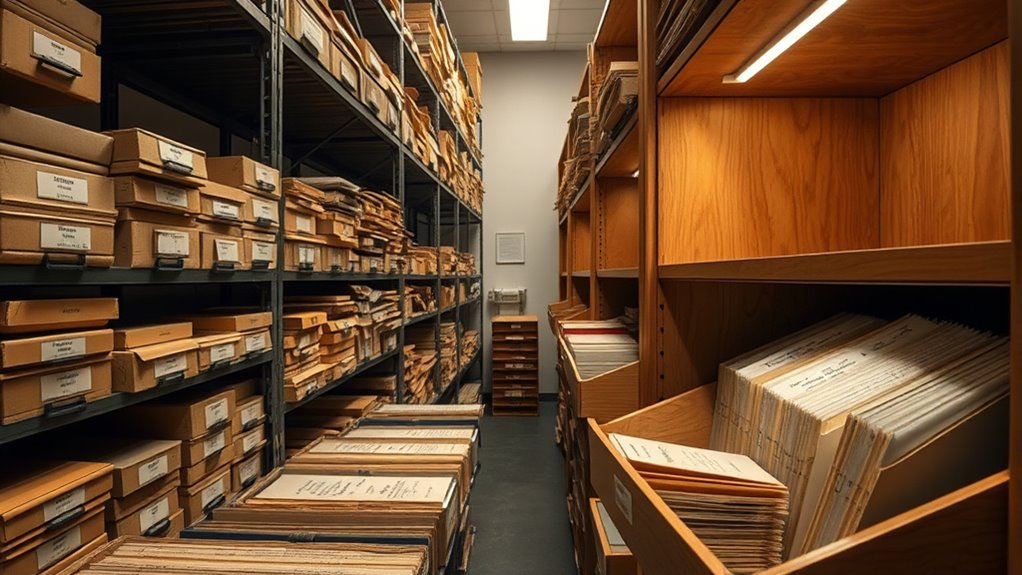To effectively preserve your collections, you should use archival-quality boxes and acid-free folders to protect against dust, light, and handling damage. Pair these with precise environmental controls like stable temperature, humidity between 30-50%, and avoiding direct sunlight or UV exposure. Regularly monitor conditions and make adjustments with HVAC or dehumidifiers. Proper handling and organized storage further extend the lifespan of your materials. Keep going to discover more ways to optimize your storage methods.
Key Takeaways
- Use acid-free, archival-quality boxes and folders to protect physical materials from deterioration.
- Maintain stable environmental conditions, including temperature around 65°F and humidity between 30-50%.
- Regularly monitor storage environments with hygrometers and thermometers for consistent climate control.
- Implement climate control measures like dehumidifiers and proper ventilation to prevent moisture damage.
- Handle items with care, using gloves and organized storage to reduce physical damage and facilitate preservation.

Archival storage methods are essential for preserving valuable documents, artifacts, and digital data over the long term. When it comes to digital preservation, choosing the right storage techniques ensures that your data remains accessible and intact for years to come. One key aspect of effective archival storage is employing proper climate control. Maintaining stable temperature and humidity levels helps prevent deterioration of physical materials and protects digital media from damage caused by environmental fluctuations. You should aim for a cool, dry environment, ideally around 65°F (18°C) with relative humidity between 30% and 50%, to slow down decay processes and inhibit mold growth. Additionally, selecting appropriate storage containers like archival-quality boxes and folders is crucial for safeguarding physical items. Acid-free boxes prevent paper acids from weakening and discoloring documents, ensuring their longevity. When storing papers, photographs, or artifacts, place them in labeled acid-free folders, which protect against dust, light, and handling damage. These folders also make it easier to organize your collection, reducing the risk of accidental tears or misplacement. For digital data, physical storage containers like archival-grade external drives or secure servers are recommended. These should be stored in environments with controlled climate conditions to prevent data corruption caused by heat or humidity. Implementing climate control extends beyond just choosing the right storage containers. You should regularly monitor environmental conditions with hygrometers and thermometers, adjusting HVAC systems as needed to maintain consistent conditions. Proper ventilation prevents the build-up of moisture, which can accelerate deterioration. In addition, avoiding exposure to direct sunlight and fluorescent lighting is essential, as UV rays can fade documents and degrade digital media surfaces over time. For digital preservation, consider creating multiple copies of important data and storing them in different locations. Regularly updating and migrating digital files to current formats prevents obsolescence and ensures ongoing accessibility. Furthermore, you should handle physical materials with clean hands or gloves to prevent oils and dirt from causing damage. When storing digital media, use robust, error-checking storage solutions that support data integrity. Combining these physical and environmental strategies maximizes the lifespan of your collection. Incorporating climate control practices, such as using dehumidifiers or climate-controlled environments, further enhances preservation efforts. Overall, integrating climate control with proper storage materials and systematic maintenance is crucial for effective archival storage. By doing so, you protect both your physical artifacts and digital data from environmental threats, ensuring they remain preserved and accessible for future generations.
Frequently Asked Questions
How Do I Choose the Right Storage Method for Fragile Items?
When choosing the right storage method for fragile items, prioritize careful fragile item handling and select appropriate storage materials. Use acid-free boxes and padded folders to prevent damage, and consider custom supports or cushioning for extra protection. Keep environmental controls in mind, such as stable temperature and humidity, to preserve your items. Always handle with care, ensuring your storage approach minimizes risk of breakage or deterioration over time.
What Are the Costs Associated With Different Environmental Controls?
You might hesitate, wondering if environmental controls strain your budget. The costs vary widely—basic temperature and humidity regulation can be affordable, but advanced systems for sensitive items skyrocket expenses. Conducting a thorough cost analysis helps you weigh options and plan your budget effectively. By understanding the true costs, you’ll feel more confident in choosing the right environmental controls, ensuring your fragile items stay safe without unexpected financial surprises.
How Often Should Archival Storage Conditions Be Monitored?
You should monitor archival storage conditions at least monthly to guarantee ideal humidity levels and pest prevention. Regular checks help you detect any fluctuations or issues early, preventing damage to your collections. Keep an eye on temperature and humidity, and inspect for pests or mold. Consistent monitoring allows you to maintain a stable environment, safeguarding your materials and ensuring their preservation over time.
Are There Eco-Friendly Alternatives to Traditional Storage Boxes?
Your archival storage options are more eco-friendly than you might think—biodegradable containers and recycled materials are great alternatives. These eco-friendly options are just as durable and protective as traditional boxes, but they help save the planet from becoming a landfill. By choosing biodegradable containers or recycled materials, you actively reduce waste and support sustainability. Embrace these greener solutions and make your archival storage both responsible and environmentally conscious.
How Can Digital and Physical Storage Methods Be Integrated Effectively?
You can effectively integrate digital and physical storage by using digital integration to catalog and track physical items, ensuring preservation strategies are aligned. Implement a unified database that links digital records with physical locations, making retrieval easy. Regularly update both systems and adopt environmentally friendly materials. This approach streamlines access, enhances preservation, and reduces environmental impact, creating a cohesive, sustainable archival system that benefits both your physical collections and digital assets.
Conclusion
By choosing the right combination of boxes, folders, and environmental controls, you can turn your collection into a well-protected treasure chest. Think of your storage space as a carefully guarded vault, where each element works together to preserve your treasures for generations. With attention to detail and the right methods, you guarantee your artifacts remain vibrant and intact, like a finely woven tapestry that tells your story for years to come.








